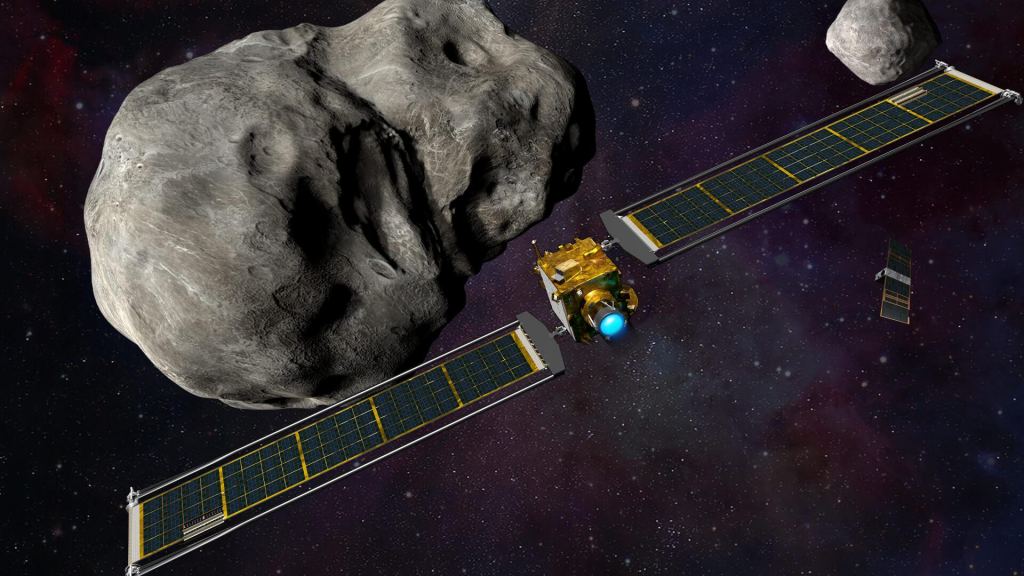NASA’s Double Asteroid Redirection Test (DART) mission is on its way to rendezvous with the double-asteroid Didymos. When it arrives on September 26th, DART will collide with Dimorphos – the 160-meter (525-foot) moonlet that orbits the main body – to evaluate the kinetic impact technique for the very first time. This proposed method of planetary defense consists of a spacecraft colliding with an asteroid to alter its orbit and prevent it from colliding with Earth. In July, DART took its first image of the double-asteroid, which NASA released earlier this week!
The image was taken on July 27th and shows Didymos as a distant speck of light against the background stars of space. The image is a composite of 243 images taken by the Didymos Reconnaissance and Asteroid Camera for Optical (Draco) when the spacecraft was about 32 million km (20 million mi) from the asteroid. At this distance, the navigation camera team was uncertain if DRACO would be able to resolve the asteroid system. Luckily, the DRACO team enhanced the resolution of the combined image that pinpointed Didymos’ location.
 Artist’s impression of the DART mission approaching the double-asteroid Didymos and its moon Dimorphos. Credit: NASA
Artist’s impression of the DART mission approaching the double-asteroid Didymos and its moon Dimorphos. Credit: NASA
This image effectively demonstrates the capabilities of DRACO and its ability to image distant objects, which is essential for the planned rendezvous with the double-asteroid. Elena Adams, the DART mission systems engineer at the Johns Hopkins University Applied Physics Laboratory (JHUAPL), explained in a recent NASA press release:
“This first set of images is being used as a test to prove our imaging techniques. The quality of the image is similar to what we could obtain from ground-based telescopes, but it is important to show that DRACO is working properly and can see its target to make any adjustments needed before we begin using the images to guide the spacecraft into the asteroid autonomously.”
This imaging campaign also tested DRACO’s ability to guide the spacecraft towards Didymos and Dimorphos. So far, the mission team has relied on navigation simulations based on images taken by the spacecraft’s other instruments. But with the asteroid system now in view, DART will need to rely on DRACO’s ability to see and process images of the double-asteroid. This will be particularly important during the final hours before DART impacts Dimorphos.
“Seeing the DRACO images of Didymos for the first time, we can iron out the best settings for DRACO and fine-tune the software,” said Julie Bellerose, the DART navigation lead at NASA’s Jet Propulsion Laboratory (JPL). “In September, we’ll refine where DART is aiming by getting a more precise determination of Didymos’ location.”
 Artist’s impression of NASA’s Double Asteroid Redirection Test (DART) spacecraft speeding toward the smaller of the two bodies in the Didymos asteroid system. Credit: NASA/JHUAPL
Artist’s impression of NASA’s Double Asteroid Redirection Test (DART) spacecraft speeding toward the smaller of the two bodies in the Didymos asteroid system. Credit: NASA/JHUAPL
Over the next three weeks, the DART team will conduct observations with DRACO every five hours to conduct corrective maneuvers. These will reduce the margin of error for the spacecraft’s final impact trajectory towards Dimorphos. The final maneuver will take place on September 25th, approximately 24 hours before impact, when the navigation team will know the position of Dimorphos to within 2 km (1.24 mi). From that point onward, DART will have to rely on its autonomous system to guide itself and collide with Dimorphos.
The European Space Agency (ESA) plans to mount a follow-up mission, the Hera spacecraft, that will launch in September 2024. When it rendezvous’ with the double-asteroid system in December 2026, the probe will examine the aftermath of the impact test by measuring the orbit of Dimorphos for any discernible changes. This will verify if the kinetic impact method can deflect asteroids and is an effective means of protecting Earth from potentially hazardous asteroids (PHAs).
Further Reading: NASA

